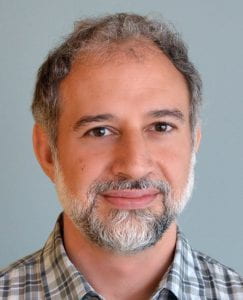“Trust your instincts, but listen to each other.”
 An interview with Aaron Batista, PhD
An interview with Aaron Batista, PhD
Associate Professor, Bioengineering Department, University of Pittsburgh
Principal Investigator, Sensory Motor Integration Laboratory and Engineering
By: Michelle Johnson (4/12/19)
When you were little, did you always want to be a scientist?
When I was a kid, people were interested in the prospect of computers mimicking human intelligence. It was always out there in the back of my mind—I remember being very intrigued by the idea of cloning and the philosophical puzzles that brought up: which is the original, which is the copy? If one copy was made of cells and the other made from silicon, is the question easier to answer? Those were the ideas that kind of captivated me as a child. It wasn’t a conscious thought to become a scientist at the time, but looking back on my childhood, I can see how the things I was curious about ended up leading me, not just to being a scientist, but being a neuroscientist and teacher.
What questions are at the forefront of your mind now?
We’ve gotten very interested in a particular notion of learning: how you form a model of the world inside your mind. You know that if you walk out of this building, you can turn right and then turn left and get to your favorite food truck. But where is that food truck in your brain right now, and how is it that you can walk that path in your mind without taking a single step? You may say, “Oh, there’s construction over there, so I’m going to turn left today,” and something in your brain changes so when you go to execute that behavior, you don’t even have to think about it. How does that happen in terms of populations of neurons and synapses?
How do you study that in the lab?
[We study] monkeys; they are a really special opportunity in neuroscience. In terms of the low-level cognitive capacities that we’ re studying in the lab, a monkey functions like a human. But because they are lab animals and we are able to directly record neural activity (we put in multi-electrode arrays which are clinically approved for humans with paralysis and can also be implanted in a monkey), we have access to a few hundred neurons while the animal is seeing, deciding, and acting. We therefore have a sophisticated animal that can be trained to do cognitive tasks, and we have access to populations of neurons. By putting these together, we can try to understand the direct links between perception, memory, decision-making, and the activity of neurons.
re studying in the lab, a monkey functions like a human. But because they are lab animals and we are able to directly record neural activity (we put in multi-electrode arrays which are clinically approved for humans with paralysis and can also be implanted in a monkey), we have access to a few hundred neurons while the animal is seeing, deciding, and acting. We therefore have a sophisticated animal that can be trained to do cognitive tasks, and we have access to populations of neurons. By putting these together, we can try to understand the direct links between perception, memory, decision-making, and the activity of neurons.
What has most surprised you about working in this field?
Everything that I learned as a graduate student I’m watching erode as new methods and new ways of analyzing data are coming on to the horizon. It’s been thrilling to watch that transformation. I’m sitting at a junction: I’m 47 years old, I graduated 25 years ago. Some people just older than me don’t have much interest in the new models, and some people slightly younger than me haven’t even read the old papers so they don’t know that there’s some gold there that they’re discarding. It feels like I’m sitting here on a paradigm shift. The surprising thing has been the transformative power of neural networks and machine learning to make us rethink, throw away some of what we were doing in the seventies and eighties, and then replace it with scientific discoveries that don’t even make sense to the people who were training just a few years before me.
What is the best piece of advice you’d give to a student interested in science?
For a student: trust your instincts because you’re probably right about more than you realize. People telling you you’re wrong are perhaps just locked into a way of thinking. Or maybe you haven’t expressed your idea clearly yet. It’s a fine balance because you need to be able to take in their point of view, but that doesn’t mean abandoning your point of view. You may be more correct than these people are giving you credit for it, but that doesn’t mean they’re wrong. It just so happens that all of these things are true. Have the confidence to believe in your ideas because they may just come back around.
If you’re on the other end of that, if you’re my age: take the mindset that everybody around you is enlightened, and everybody around you sees something that you’re not seeing. Try not to be so attached to your own ideas, because the student who just muttered something that distracts you from what you’re lecturing on is probably onto something that you should stop and listen to. The advice on both sides is trust your instincts, but listen to each other.
To learn more about Dr. Batista and his work, click here.
Click here to go back to the “Interviews with Scientists” page.
